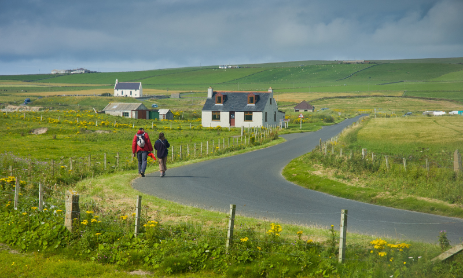Most of Scotland is Rural, and Plans for Net Zero Must Make That Work
Published: 3 October 2023
Commentary
Graeme Roy, Professor of Economics, and Dr Rob Richardson, Research Associate for International Public Policy Observatory, examine how rural areas present a distinctive set of challenges, as well as opportunities, on the road to net zero.
In this article Graeme Roy, Professor of Economics, and Dr Rob Richardson, Research Associate for International Public Policy Observatory, examine the unique challenges and opportunities that rural areas face in the transition to net zero.

"The Scottish Government distinguishes between accessible rural areas, which are within a 30-minute drive of a town of 10,000 people, and remote rural areas. Two-thirds of Scotland's rural population live in accessible rural areas.
This reminder that rural areas are not one-size-fits-all helps to explain the variation in local emissions targets. For example, many cities, including Glasgow and Edinburgh, are aiming for net zero by 2030.
Rural areas have important assets that can help them achieve net zero, especially for generating renewable energy.
The Highlands and Islands Enterprise 5-year strategy aims to make net zero a core part of the region's economy, and identifies developing renewable energy capacity as a key opportunity. This includes offshore wind and marine energy.
Scotland already generates 57% of its electricity from renewable sources, compared to 36.2% in England and Wales. Another 3.4 gigawatts of new renewable energy capacity is under construction, a 25% increase on current capacity. Most of this is offshore wind farms in the Moray Firth.
The new Inverness and Cromarty Firth Green Freeport aims to capitalise on this renewable energy capacity, while also reducing economic dependence on North Sea oil and gas. However, it is important to ensure that communities support major national projects, as the installation of infrastructure such as wind turbines can be controversial.
The UK has made little progress in reducing CO2 emissions outside the energy sector, particularly in the difficult sectors of transport, industry, housing, and agriculture. Rural areas in Scotland face unique challenges in contributing to this reduction, but they will play an important and intriguing role in the urgent journey to net zero.
The Scottish Government has set a target of net zero emissions of all greenhouse gases by 2045, which is more ambitious than the UK Government's target of 100% reduction by 2050. However, Scotland is falling behind on its emissions targets and on plans to decarbonise transport and buildings, so further-reaching solutions will be needed."
Read the article on the International Public Policy Observatory website
First published: 3 October 2023

